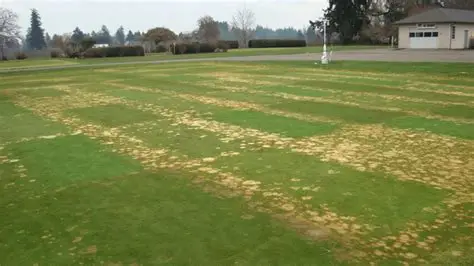Turf diseases are a significant concern for homeowners, landscapers, and golf course managers alike. These diseases can manifest in various forms, including fungal infections, bacterial issues, and viral pathogens, each presenting unique challenges to turf health. Fungal diseases, such as brown patch and dollar spot, are particularly notorious for their rapid spread and the damage they can inflict on lawns.
Brown patch, for instance, thrives in warm, humid conditions and can quickly turn lush green grass into unsightly brown patches. Understanding the life cycle of these pathogens is crucial for effective management. Fungi reproduce through spores that can be dispersed by wind, water, or even human activity, making it essential to recognize the environmental conditions that favor their growth.
In addition to fungi, bacterial and viral diseases can also compromise turf quality. Bacterial wilt, for example, can lead to the wilting and eventual death of grass plants, while viral infections often result in stunted growth and discoloration. The symptoms of these diseases can sometimes be mistaken for other issues such as nutrient deficiencies or environmental stressors.
Therefore, accurate diagnosis is critical. Turf managers must be equipped with the knowledge to differentiate between various diseases and understand their specific symptoms, which can range from leaf spots to overall decline in vigor. This understanding lays the groundwork for effective management strategies that can mitigate the impact of these diseases on turf health.
Proper Turf Maintenance
Mowing Height and Blade Maintenance
Maintaining the correct mowing height is essential; cutting grass too short can stress the plants and make them more susceptible to disease. For most cool-season grasses, a height of 2.5 to 4 inches is recommended, while warm-season grasses typically thrive when mowed to a height of 1 to 3 inches. Additionally, using sharp mower blades ensures clean cuts, reducing the risk of injury to the grass and minimizing entry points for pathogens.
Aeration and Soil Health
Aeration is another critical aspect of turf maintenance that enhances soil health and promotes vigorous grass growth. Compacted soil can hinder root development and water infiltration, creating an environment conducive to disease. Aerating the lawn allows for better air exchange and nutrient absorption, fostering a robust root system that can withstand stressors.
Additional Practices for Optimal Turf Conditions
Furthermore, regular dethatching helps remove excess organic matter that can harbor pathogens. By maintaining optimal turf conditions through these practices, turf managers can significantly reduce the likelihood of disease outbreaks.
Choosing Disease-Resistant Turf Varieties
Selecting disease-resistant turf varieties is a proactive approach to managing turf health and minimizing the risk of disease. Advances in plant breeding have led to the development of grass cultivars specifically designed to resist common turf diseases. For instance, certain varieties of Kentucky bluegrass have been bred for resistance to brown patch and other fungal diseases, making them ideal choices for homeowners in regions prone to such issues.
Similarly, fine fescue grasses are known for their shade tolerance and resistance to various diseases, making them suitable for low-light areas. When choosing turf varieties, it is essential to consider local climate conditions and soil types. For example, zoysiagrass is well-suited for warm climates and exhibits good resistance to drought and wear, while tall fescue is favored in transitional zones due to its adaptability and disease resistance.
Consulting with local extension services or turfgrass specialists on turf varieties in Sydney can provide valuable insights into which varieties perform best in specific regions. By selecting disease-resistant cultivars tailored to local conditions, turf managers can establish a resilient lawn that requires less intervention and is better equipped to fend off potential diseases.
Implementing Good Watering Practices
Watering practices play a crucial role in maintaining healthy turf and preventing disease outbreaks. Overwatering is one of the most common mistakes made by homeowners and turf managers alike. Excess moisture creates an environment conducive to fungal growth, leading to diseases such as root rot and leaf spot.
To avoid this pitfall, it is essential to adopt a deep and infrequent watering strategy. This approach encourages deep root growth and helps grass plants develop resilience against drought conditions while minimizing the risk of waterlogged soil. Timing is also critical when it comes to watering practices.
Early morning is the ideal time to irrigate lawns, as it allows grass blades to dry out during the day, reducing humidity levels that favor fungal growth. Watering in the evening or at night can leave grass wet for extended periods, increasing susceptibility to diseases. Additionally, utilizing smart irrigation systems or moisture sensors can help optimize watering schedules based on current weather conditions and soil moisture levels.
By implementing these good watering practices, turf managers can create an environment that supports healthy grass growth while minimizing disease risks.
Fertilizing and Nutrient Management
Fertilizing and nutrient management are integral components of maintaining healthy turf that can resist diseases effectively. A well-balanced fertilization program provides essential nutrients that promote vigorous growth and enhance the overall resilience of grass plants. Nitrogen is particularly important for turf health; however, excessive nitrogen application can lead to lush growth that is more susceptible to disease.
Therefore, it is crucial to follow soil test recommendations when determining nutrient needs. In addition to nitrogen, other macronutrients such as phosphorus and potassium play vital roles in turf health. Phosphorus supports root development, while potassium enhances drought resistance and overall plant vigor.
Micronutrients like iron and manganese are also important but are often overlooked in fertilization programs. Applying fertilizers at the right time—typically during the growing season—ensures that nutrients are available when grass plants need them most. Moreover, using slow-release fertilizers can provide a steady supply of nutrients over time, reducing the risk of nutrient leaching and promoting sustained growth.
Monitoring and Early Detection
Recognizing Common Symptoms
Regular monitoring of turf health is crucial for early detection of potential diseases before they become significant problems. Turf managers should be familiar with common symptoms associated with various turf diseases to identify issues promptly. Regular inspections of grass color, texture, and overall vigor can reveal subtle changes that may indicate underlying problems.
Using Diagnostic Tools and Data Collection
For instance, yellowing leaves may signal nutrient deficiencies or disease onset. In addition to visual inspections, employing diagnostic tools such as soil moisture meters or temperature sensors can provide valuable data on environmental conditions that may favor disease development. Keeping records of weather patterns—such as humidity levels and rainfall—can also aid in predicting disease outbreaks based on historical trends.
Implementing Timely Interventions
By establishing a routine monitoring program that includes both visual assessments and data collection, turf managers can implement timely interventions that prevent minor issues from becoming major threats.
Implementing Integrated Pest Management
Integrated Pest Management (IPM) is a holistic approach that combines various strategies to manage turf diseases effectively while minimizing environmental impact. This method emphasizes prevention through cultural practices, biological controls, and judicious use of chemical treatments when necessary. For instance, introducing beneficial microorganisms into the soil can help suppress harmful pathogens naturally without relying solely on chemical fungicides.
Cultural practices such as proper mowing techniques, aeration, and appropriate watering schedules form the foundation of an effective IPM program. By creating an environment that promotes healthy grass growth and reduces stressors, turf managers can significantly decrease the likelihood of disease outbreaks. When chemical interventions are required, IPM advocates for targeted applications based on monitoring data rather than blanket treatments.
This approach not only conserves resources but also minimizes potential harm to beneficial organisms in the ecosystem.
Utilizing Cultural Practices
Cultural practices are fundamental in establishing a new lawn in Australia that is capable of withstanding diseases effectively. These practices encompass a wide range of activities aimed at promoting healthy grass growth while minimizing stress factors that contribute to disease susceptibility. For example, proper mowing techniques not only enhance aesthetic appeal but also play a crucial role in maintaining turf health.
Mowing at the correct height prevents scalping and encourages deeper root development while allowing adequate sunlight penetration. Another vital cultural practice is overseeding, which involves introducing new grass seed into existing lawns to improve density and diversity. This practice not only enhances the lawn’s appearance but also increases its resilience against pests and diseases by promoting competition among grass species.
Additionally, maintaining proper soil pH levels through regular testing ensures optimal nutrient availability for grass plants. By implementing these cultural practices consistently, turf managers can create a robust lawn ecosystem that thrives under various conditions while effectively resisting diseases. In summary, understanding turf diseases requires a multifaceted approach encompassing proper maintenance techniques, selection of resistant varieties, effective watering practices, nutrient management strategies, vigilant monitoring for early detection, integrated pest management principles, and cultural practices aimed at promoting overall health.
Each component plays a vital role in creating a sustainable turf environment capable of thriving despite potential challenges posed by diseases.









